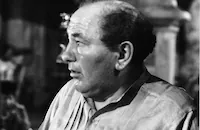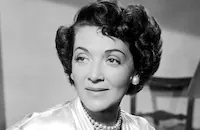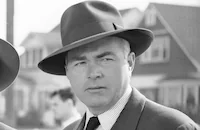Live, Love and Learn

Brief Synopsis
Cast & Crew
Geo. Fitzmaurice
Robert Montgomery
Rosalind Russell
Robert Benchley
Helen Vinson
Monty Woolley
Film Details
Technical Specs

Synopsis
When society girl Julie Stoddard crashes into Bohemian artist Bob Graham's easel during a fox hunt, he thinks she is too pampered to appreciate life outside her insulated existence. A short time later they are married, even though Bob tries his best to dissuade her during the wedding ceremony. At Bob's New York apartment, Julie is happy to live an ordinary life, but he still promises to "paint his darndest" to provide her with the luxuries to which she is accustomed. He has little success selling his work until he inadvertently causes a riot in Central Park when some marines and sailors fight over the merits of a picture he is painting. A newspaper description of Bob's paintings piques the interest of art dealer Charles C. Bawltitude, who offers to show them in his gallery, even though Bob, Julie and their friend Oscar rough up him when they think he is a reporter. The show is a success and Bob becomes a society darling. Soon, under the guidance of Julie's snobbish friend, Lily Chalmers, Bob rents a swank apartment and begins to prefer luxuries to the simple life. Bob begins taking large commissions for portraits of rich patrons, but his artistic integrity suffers and Julie becomes increasingly unhappy. When Lily obtains a commission for him to paint a race horse that belongs to the wealthy Mr. Palmiston, on the same day that Bob alters a portrait to flatter a society woman, Julie is disgusted. She is even more upset, though, when Bob rudely dismisses Professor Fraum of a local art school when Fraum asks him to attend a "Robert Graham Evening" he has planned for the school. When Julie then paints a moustache on the portrait and is congratulated by Oscar, Bob orders him to get out, after which Julie asks for a divorce. A few weeks later, while Bob is taking a steam bath to cure a hangover, he encounters Bawltitude, who tells him he has sold his talent and will never paint anything good again. Stung by the comments, Bob picks up a street urchin to pose for him and attempts to recapture his talent. After repeatedly trying to paint the boy, though, Bob becomes convinced that Bawltitude is right. Meanwhile, Lily goes to Julie to deny that she has had any part in breaking up her marriage, but Julie tells her to leave, then plots with Oscar to get Bob back. The next day, Oscar goes to Bob and tells him that Julie still wants a divorce, and Bob reluctantly agrees and offers to provide grounds that night. Oscar suggests returning to his old studio for the occasion, but Bob says that he must first speak to Professor Fraum's class. While Julie secretly listens, Bob tells Fraum's students to learn from his mistakes and not compromise their art for financial gains or measure their success by money. Later, at the studio, Julie arrives, instead of a paid corespondant, and she and Bob reconcile. Finally, to prove to Bawltitude that he will regain his talent, Bob steals the race horse potrait from Palmiston, and when Palmiston shows up, Bawltitude joyfully helps Bob, Julie and Oscar push Palmiston through the painting.

Director

Geo. Fitzmaurice
Cast

Robert Montgomery

Rosalind Russell

Robert Benchley

Helen Vinson

Monty Woolley

E. E. Clive

Mickey Rooney

Charles Judels

Maude Eburne
Harlan Briggs

June Clayworth
Barnett Parker
Al Shean

James Flavin
Jack Pennick
Frank Sully
Jerry Miley
Russ Clark
George Cooper

Billy Gilbert
Dorothy Appleby
Ena Gregory
Kate Price
Heinie Conklin
Billy Dooley
John Kelly
Joe Caits
Philip Tully
John Quillan
Frank Marlowe
Don Barclay
Harry Lash
Milt Kibbee
Ralph Mccullough
Edith Kingdon
Mariska Aldrich
Chester Clute
Ramsey Hill
Edward Earle
Carl Leviness
Arthur Stuart Hull
Adrienne D'ambricourt
John Davidson
Robert Emmett Keane
William Austin
Winifred Harris

Ann Rutherford
Billy Engle
Zeffie Tilbury
Wilbur Mack
Minerva Urecal
Virginia Sale
Maxine Elliott Hicks
Tenen Holtz
Margaret Lyman
Leila Mcintyre
Rollo Lloyd

Charles Irwin
Robert Spindola

Soledad Jimenez

Eddie Gribbon
Crew
Charles Brackett
Helen Grace Carlisle
Cedric Gibbons
Cyril Hume
Ray June
Richard Mairbaum
Harry Mcafee
Conrad A. Nervig
Marion Parsonnet
Harry Rapf
Joseph Ruttenberg
Douglas Shearer
Al Shenberg
Dolly Tree
Edward Ward
Edwin B. Willis

Photo Collections
Film Details
Technical Specs

Articles
Live, Love and Learn
Live, Love and Learn was very much a product of the studio era. MGM was dedicated to turning out a film a week in the '30s, keeping their stars in front of the public in a variety of genres designed to capitalize on the appeal of established players like Montgomery while building the popularity of developing stars like Russell. With their roles in a thriller that unconventionally (and against studio head Louis B. Mayer's better judgment) cast Montgomery as a serial killer who romances Russell already completed, they moved to more solid box-office ground with this tale of an heiress who gives up her fortune to marry a struggling artist only to see his first success turn him into a sell-out. Montgomery had already earned a reputation as a light comedian in films such as Private Lives (1931) and When Ladies Meet (1933), but this was Russell's first brush with screwball comedy after a series of more patrician roles.
To direct the film, the studio assigned the dependable if far from dazzling George Fitzmaurice, who was best known for such romantic dramas as Raffles (1930) and Mata Hari (1931). If the story was a busy mess, it may be because of the number of hands involved in the writing process. The original plot was an adaptation of an original story by Helen Grace Carlisle and eventually had three credited screenwriters. Richard Maibaum had only recently arrived in Hollywood following success on Broadway, though he would go on to his greatest fame as the screenwriter of thirteen of the James Bond films, from the first, Dr. No (1962), through Licence to Kill (1989). Cyril Hume had worked on the script for MGM's classic Tarzan, the Ape Man (1932) and would continue to team with Maibaum through the years. If neither seems the perfect choice for a screwball comedy, throw in Charles Brackett, on loan from Paramount. The urbane Brackett would soon find his perfect writing partner in future director Billy Wilder, with whom he would team for such dazzling comic scripts as Midnight and Ninotchka (both 1939). Perhaps it was Brackett, who was gay, who contributed the jokes about a male decorator and his "partner" and the strange friendship between Montgomery and his former roommate (played by Robert Benchley).
Live, Love and Learn also includes a pair of in-jokes for film fans. When journalists begin to hound the newly famous Montgomery, Benchley warns them that "He wants to be alone," a clear reference to the studio's most famous female star, Greta Garbo. At another point, Montgomery puts a drunken Benchley to sleep on his couch, then covers his face with a rag and says "Now he looks like a decapitated corpse." In Night Must Fall, Montgomery had played a killer who not only decapitates his victims, but carries a severed head around in a hatbox. It's doubtful that the writers were aware of how future generations would view another plot development. Desperate to get back in touch with his talents after languishing as a society portraitist, Montgomery pays an Italian immigrant to have her young son model for him, which the boy does, wearing nothing but a fig leaf. Considered comic at the time, the scene today seems more cringe-worthy.
Like most studio films of Hollywood's golden age, Live, Love and Learn features an array of supporting players churning out films at an often amazing rate. These include Maude Eburne (seven films that year), Al Shean (eight), Zeffie Tilbury (thirteen), Minerva Urecal (thirteen), E.E. Clive (seventeen), Charles Judels (eighteen) and Billy Gilbert (twenty-two, including the voice of Sneezy in Snow White and the Seven Dwarfs). Mickey Rooney's small role was one of seven he played that year, but it would be one of his last supporting performances. Live, Love and Learn was made only a few months after A Family Affair (1937), the first of the Hardy family films. Before the year's end, he would shoot to stardom with a larger role in the first real Andy Hardy film, You're Only Young Once.
Though she wasn't credited for her performance as an art school's class president in Live, Love and Learn, Ann Rutherford (a slow starter with only six 1937 credits) would rise to fame alongside Rooney as his small-town sweetheart, Polly Benedict, in the Hardy films. Also on the road to stardom was Monty Woolley, a Broadway favorite making his film debut here (though his second film, Nothing Sacred, would reach theaters first). He would achieve his greatest success as acerbic columnist Sheridan Whiteside in the stage and screen versions of The Man Who Came to Dinner (1942).
Although less of a critical success than Night Must Fall, Live, Love and Learn probably performed better at the box office, presenting Montgomery as his fans would have preferred. The stars would re-team in 1939 for Fast and Loose, an attempt to create another husband-and-wife detective series like The Thin Man (1934), ironic since Russell had been brought to MGM as back-up in case that series' star, Myrna Loy, grew difficult. Also ironic is Russell's casting just a year after Live, Love and Learn, once again playing a wife trying to keep her husband from selling out, in the award-winning medical drama The Citadel (1938).
Producer: Harry Rapf
Director: George Fitzmaurice
Screenplay: Charles Brackett, Cyril Hume, Richard Maibaum
Based on a story by Marion Parsonnet, suggested by a story by Helen Grace Carlisle
Cinematography: Ray June
Art Direction: Cedric Gibbons
Music: Edward Ward
Cast: Robert Montgomery (Bob Graham), Rosalind Russell (Julie Stoddard), Robert Benchley (Oscar), Helen Vinson (Lily Chalmers), Mickey Rooney (Jerry Crump), Monty Woolley (Mr. Bawltitude), E.E. Clive (Mr. Palmiston), Maude Eburne (Mrs. Crump), Al Shean (Professor Fraum), Billy Gilbert (Newsboy), Ann Rutherford (Class President), Zeffie Tilbury (Mrs. Venable).
BW-79m.
by Frank Miller

Live, Love and Learn
Quotes
Trivia
Notes
According to a news item in Film Daily, Joseph Ruttenberg photographed the picture for a few days during Ray June's illness. This was Monty Woolley's first screen appearance. Although Nothing Sacred, in which Woolley also appeared in late 1937, began production several weeks prior to the production of Live, Love and Learn, the former film was not released until several weeks after the latter. It has not been determined if Woolley began work on Nothing Sacred before or after he worked on Live, Love and Learn^.















